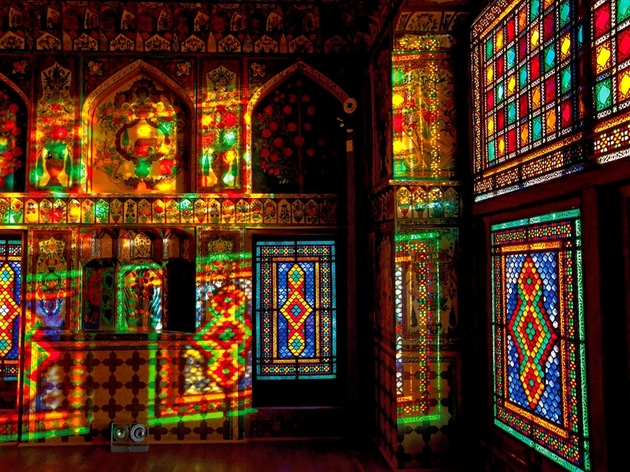Azerbaijan Sheki is one of the oldest cities in the Caucasus region, believed to date back to the late Bronze Age, circa 700 BC. Charukesi Ramadurai wrote an article for The National, discussing this beautiful city.
I feel like Alice in Wonderland. Except, instead of falling into a rabbit hole, I have stepped into a kaleidoscope, where sunlight and coloured glass are playing off each other to create shape-shifting mosaics. I am at the Khan’s Palace in Sheki, a small town in the northwest of Azerbaijan surrounded by the Caucasus Mountains. A recent addition to the Unesco World Heritage List, Sheki Khan’s Palace, also known as Sheki Xan Sarayi, was built in the late 1700s by Muhammad Huseyn Khan, and is part of a sprawling fortress complex perched high on one end of this charming town.
My first impression of the palace, one of the few restored buildings on the grounds, is of a colourful two-storey mansion set against towering chinar trees. The facade is exquisite – a dazzling montage of blue, turquoise and brown tiles in neat geometric and floral patterns, punctuated only by wooden windows. As architecture goes, the mansion is fairly simple – two identically laid out levels, with three long rectangular rooms in each.

However, I had not anticipated the profusion of colour inside the palace – a combination of stained glass and murals. Every inch of wall and ceiling space is covered in lush frescoes in floral motifs, with hunting and battle scenes depicting the might of the ruling Khans. Each of the stained glass windows stands out as a work of art in itself, while the ceiling in the main room on the lower level is entirely set in pieces of cut glass, spreading out like the late evening sky.
The windows were created using the traditional art of shebeke, Azerbaijan’s answer to European stained glass. I learn from my guide that restoration work had been ongoing at the palace since the mid-1950s, finally grinding to a halt in 2002. Not surprisingly, the project was handled not only by a team of architects, but also the best shebeke artists in town.
I follow the trail of the shebeke – a craft as old as the palace itself – down through the fortress complex to the Abad arts and crafts complex. Sheki is also part of the Unesco Creative Cities Network, because of its rich heritage in 18 craft forms, including embroidery, pottery, weaving and music, among other things. Of these, the undisputed star is the shebeke, a sophisticated jigsaw puzzle of wooden lattices of walnut or oak, into which coloured glass pieces in primary colours such as blue, red and yellow are set, without the help of glue or nails. At a shebeke workshop, master craftsman Husein Hajimustafazadeh demonstrates his impressive skill, typically passed on from father to son. A single window pane can involve thousands of pieces, he declares nonchalantly, as his fingers work deftly, as if possessing a life of their own.
Sheki is one of the oldest cities in the Caucasus region, believed to date back to the late Bronze Age, circa 700 BC. The town has seen Persians, Romans, Arabs, Mongolians and, most recently, Russians, come and go. Through it all, it seems to have held on to its Caucasian identity, while assimilating the best cultural influences of its international visitors. I had experienced one of these melting-pot moments earlier in the day in the village of Kish, just outside the main town. I made the trip there mainly to visit its recently restored church, again the oldest in the Caucasus, believed to have been established in the first century by St Elysee (locally known as Elishe). In its several centuries of existence, the Church of Kish has served as a Caucasian Albanian Apostolic Church, an Armenian Apostolic Church, the residence of a Georgian Orthodox bishop and now a museum.
But Sheki really came into its own as a pit stop on the Silk Road, when it found fame as a centre for silkworm breeding and trade in silk cocoons. The Caucasus region is not generally known as a place of prominence on this famed trade route that connected China with Turkey through the lofty mountains of the Hindu Kush, but there were routes that branched out into Central Asia, including Azerbaijan. Locals bartered Murano glass from Italy and ceramics from the Ottomans in exchange for their own silks and spices. And they put it all to good use in their palaces, I muse, the glittering shebeke still in my mind.
In town, the most visible icons of Sheki’s Silk Road legacy are the two caravanserais – early 19th-century inns for travellers and traders to rest for the night – that are still standing. I walk into the Yukhari Karvansaray Hotel, an erstwhile caravanserai renovated and repurposed into a guesthouse, to get an idea of how things may have been. An open central courtyard, where I imagine camels were once tethered and fed, is surrounded by arched corridors leading into sparse guest rooms. On one side of this courtyard, I chance upon the cayxana, a teahouse where I am welcomed into one of the cozy stone alcoves along with my friends. A young waiter soon brings in a samovar, while another carries a tray with crockery and small bites.

Tea (locally, cay or chai) is not just a beverage, but a ritual in Azerbaijan. It is brewed in the samovar and served in tulip glasses, along with sugar cubes that are to be placed between the teeth, the unsweetened tea sucked through them. And if that sugar quotient is not enough, there is a variety of baklava, Turkish delights, sweetened nuts and murabba (fruit preserves) served along with it. As I lay back on the floor cushions and bite into a sweet white cherry, I do indeed feel like I have been transported back to an earlier time of plenty.






